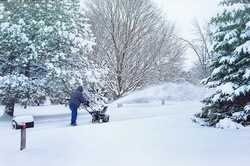
Defective snowblower components can trigger dramatic failures that can result in serious injuries or death. Poor design, manufacturing defects, and the use of substandard components are common causes of snowblower failures. When defective machinery causes injury or death, the designer, manufacturer, and distributor may be liable for the injuries their negligence caused. Unsurprisingly, the majority of snowblower injuries are clustered around the day of, and in the days immediately following major snowfall in the area.
Hand and Finger Injuries Caused by Snowblowers
Injuries to the fingers and hands are common types of snowblower injuries. 9 out of 10 times, hand injuries occur to the user’s dominant hand. One reason is that people often use their dominant hand to clear the machines of wet snow. When personal injuries occur, they can include fractures and lacerations. In many instances, the injuries are severe and require amputation. In addition to the medical expenses this creates, amputation of a finger or hand can severely diminish the individual’s quality of life and the ability to perform work-related tasks.
From 2002 through 2008, a total of 32,307 snowblower-related injuries were treated in hospital emergency rooms and recorded within the National Electronic Injury Surveillance System. Of the injuries to the hand that were recorded, 42% involved fractures, and 20% resulted in amputations. Fatalities are rare, but they do occur. From 1992 through 2015, a total of 19 people died in incidents involving snowblowers. These fatalities occurred when the individual became entangled in the machine or suffered carbon monoxide poisoning.
On average, approximately 4,615 hand injuries caused by snowblowers are recorded each year. 90% of those who are injured are men. About 42.7% were between 40 and 59 years old, 27.4% were 60 years or older, and 23% were between the ages of 20-39. A small percentage, only 5.9% were under the age of 19.
Over 90% of patients who suffer injuries to their hand from a snowblower do not require hospital admission. However, between 3.2% and 8.3% require at least one overnight stay for treatment. These injuries often occur when the fingers and hands come into contact with a rotating auger blade.
Snowblower Recalls
There have been numerous recalls of snowblowers over the past couple of decades. In 2012, Brigs & Stratton recalled their snowblowers because of a faulty carburetor bowl nut. This defect allowed for the escape of gasoline and created a significant fire hazard for users. This problem was similar to a 2006 recall in which Toro was forced to recall 84,000 snowblowers following the development of cracks within their unit’s plastic gas tanks.
In 2011, Sno-Tek recalled snowblowers manufactured by the company when it was discovered that a safety shield located near the starter could cause deep lacerations to fingers.
In one of the largest recalls, MTD Product, Inc. recalled 130,000 snowblowers. These units had plastic wheels that could explode while rotating. These explosions created shrapnel that caused severe lacerations and even broken bones to users.
The most recent snowblower recall occurred in June 2018. Nearly 35,000 snowblowers manufactured by Amerisun are under recall because of defective pulley bolts that can come loose. When the bolt fails, the snowblower gets suck in drive position and can become uncontrollable.
Common Snowblower Faults
Snowblowers rely on multiple components for smooth and safe operation. When any one component fails, it destabilizes the unit and makes it unsafe to operate. These failures can occur suddenly and without prior indication of potential problems.
Common parts failures include damaged wheels which can deflate or become detached from the frame. This can cause the unit to veer out of control and run over the user’s feet or into the legs and feet of individuals near the machine.
Similarly, defective or clogged v-belts, as well as defective drive disks, can stop the machine in its tracks. This can cause the machine to lurch violently which can cause the user to slip and fall.
Fuel system problems pose a serious risk of fire. These can include damaged carburetors, faulty carburetor gaskets, improperly attached fuel filters, and cracked gas tanks. When these faults occur, they can spill liquid fuel onto hot engine components. This can result in sudden, and potentially explosive combustion.
Defective impellers can clog and lead to jamming. In most cases, a jam of this type activates the kill switch and shuts the machine down. However, when users attempt to clear these jams by hand, their hands or fingers can suffer injuries as built up rotational force is released.
Finally, defective cable controls are a common cause of snowblower failures. When the cable freezes in place or snaps, it eliminates the user’s ability to control throttle or the unit’s direction.

